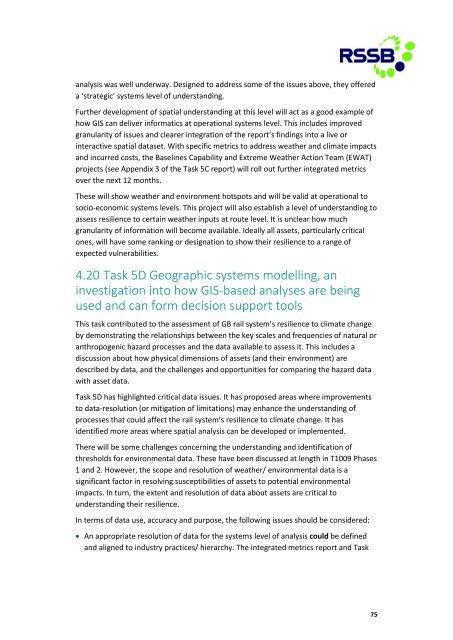Tomorrow's Railway and Climate Change Adaptation Final Report
2016-05-T1009-final-report
2016-05-T1009-final-report
Create successful ePaper yourself
Turn your PDF publications into a flip-book with our unique Google optimized e-Paper software.
analysis was well underway. Designed to address some of the issues above, they offered<br />
a ‘strategic’ systems level of underst<strong>and</strong>ing.<br />
Further development of spatial underst<strong>and</strong>ing at this level will act as a good example of<br />
how GIS can deliver informatics at operational systems level. This includes improved<br />
granularity of issues <strong>and</strong> clearer integration of the report’s findings into a live or<br />
interactive spatial dataset. With specific metrics to address weather <strong>and</strong> climate impacts<br />
<strong>and</strong> incurred costs, the Baselines Capability <strong>and</strong> Extreme Weather Action Team (EWAT)<br />
projects (see Appendix 3 of the Task 5C report) will roll out further integrated metrics<br />
over the next 12 months.<br />
These will show weather <strong>and</strong> environment hotspots <strong>and</strong> will be valid at operational to<br />
socio-economic systems levels. This project will also establish a level of underst<strong>and</strong>ing to<br />
assess resilience to certain weather inputs at route level. It is unclear how much<br />
granularity of information will become available. Ideally all assets, particularly critical<br />
ones, will have some ranking or designation to show their resilience to a range of<br />
expected vulnerabilities.<br />
4.20 Task 5D Geographic systems modelling, an<br />
investigation into how GIS-based analyses are being<br />
used <strong>and</strong> can form decision support tools<br />
This task contributed to the assessment of GB rail system’s resilience to climate change<br />
by demonstrating the relationships between the key scales <strong>and</strong> frequencies of natural or<br />
anthropogenic hazard processes <strong>and</strong> the data available to assess it. This includes a<br />
discussion about how physical dimensions of assets (<strong>and</strong> their environment) are<br />
described by data, <strong>and</strong> the challenges <strong>and</strong> opportunities for comparing the hazard data<br />
with asset data.<br />
Task 5D has highlighted critical data issues. It has proposed areas where improvements<br />
to data-resolution (or mitigation of limitations) may enhance the underst<strong>and</strong>ing of<br />
processes that could affect the rail system’s resilience to climate change. It has<br />
identified more areas where spatial analysis can be developed or implemented.<br />
There will be some challenges concerning the underst<strong>and</strong>ing <strong>and</strong> identification of<br />
thresholds for environmental data. These have been discussed at length in T1009 Phases<br />
1 <strong>and</strong> 2. However, the scope <strong>and</strong> resolution of weather/ environmental data is a<br />
significant factor in resolving susceptibilities of assets to potential environmental<br />
impacts. In turn, the extent <strong>and</strong> resolution of data about assets are critical to<br />
underst<strong>and</strong>ing their resilience.<br />
In terms of data use, accuracy <strong>and</strong> purpose, the following issues should be considered:<br />
• An appropriate resolution of data for the systems level of analysis could be defined<br />
<strong>and</strong> aligned to industry practices/ hierarchy. The integrated metrics report <strong>and</strong> Task<br />
75


